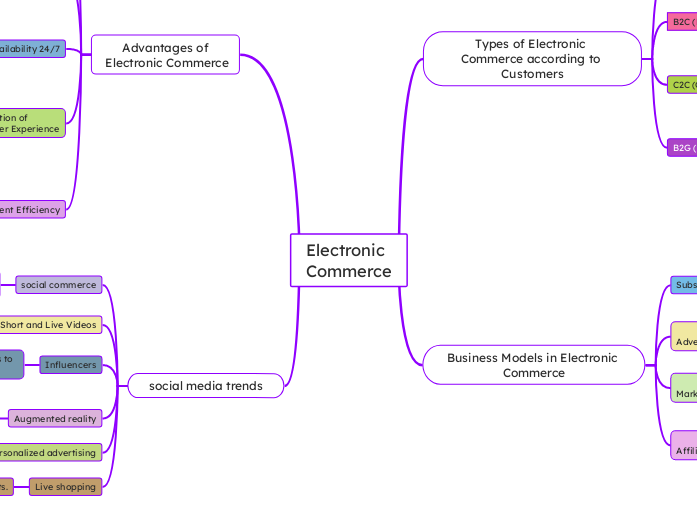Electronic
Commerce
Types of Electronic Commerce according to
Customers
B2B (Business to Business)
Companies that sell to other companies
Example: Industrial materials suppliers
B2C (Business to Consumer)
Companies that sell directly to consumers
Example: Amazon, online clothing stores
C2C (Consumer to Consumer)
Consumers who sell to other consumers
Example:eBay, MercadoLibre, Wallapop.
B2G (Business to Government)
Companies that sell products or services to governments.
Example: Public tenders, infrastructure contracts.
Business Models in Electronic Commerce
Subscription Model
Customers pay a recurring fee for access to products or services.
Example: Netflix, Spotify.
Advertising Model
Revenue comes from advertisements presented to users.
Example: Google, Facebook.
Market Model
Platforms where buyers and sellers interact
Example: Amazon, eBay
Affiliate Model
Sellers earn a commission for referring other buyers.
Example: Blog affiliate programs, Amazon Associates.
Advantages of
Electronic Commerce
Global Market Access
Global expansion without geographical barriers.
Reach customers in different time zones.
Reduction of Operating Costs
Less need for physical stores.
Reduction in personnel and rental costs.
Availability 24/7
Businesses do not have limited hours
Allows purchases at any time
Personalization of
the Customer Experience
Using data to recommend products
Better adaptation to customer needs
Inventory Management Efficiency
Better control through technological tools.
Less losses due to unsold products.
social media trends
social commerce
Buy direct from platforms like Instagram and TikTok.
Short and Live Videos
Using dynamic content and live streams to promote products.
Influencers
Marketing through content creators to promote products.
Augmented reality
Try products virtually to improve the online shopping experience.
Personalized advertising
Ads targeted to specific audiences based on their behavior
Live shopping
Buy products during live broadcasts.
